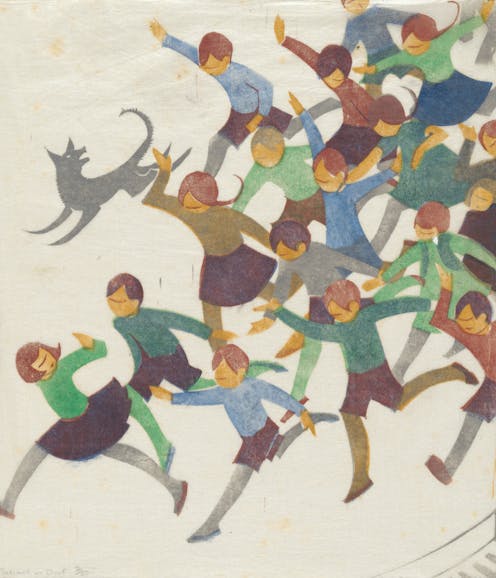
Review: Spowers & Syme, Geelong Gallery.
In their pioneering coloured linocut prints, Ethel Spowers (1890-1947) and Eveline Syme (1888-1961) captured the flux and excitement of an era of rapid change.
Their modernist interpretations of Australia in the interwar period have both a complexity and a simplicity. Colour is simultaneously bold and subtle; lines vigorous and delicate. Rhythm, arcs and movement populate their images of everyday spaces, people and places.
Yet, despite initial recognition in their time, Spowers and Syme have been largely forgotten.
Now, a new exhibition meticulously curated by Sarina Noordhuis-Fairfax plots their friendship, influences and creative development in the decades after the first world war – a time when new freedoms were afforded to women of their means.
Read more: Beauty and audacity: Know My Name presents a new, female story of Australian art
Discovering a new art form
Spowers and Syme were childhood friends from rival media families who ran competing newspapers, The Argus and the Age. Spowers studied art and Syme studied classics. As young women, both had developing art practices in painting and printmaking.
They had regularly travelled “abroad” and knew the world beyond Australia was transforming in exciting ways. By the late 1920s, they decided to be part of it.

Seeking the energy and liveliness of the London art scene, both women left Australia to learn linocut printing from Claude Flight at the Grosvenor School of Modern Art.
Linoleum, a new flooring material adopted by artists from 1900, was a cheap and accessible way to make prints. Flight saw the colour linocut print as a modern medium for a modern age: a medium that enabled innovation to respond to the excitement of the times.
Flight revolutionised printmaking in the UK. His work drew on cubism and futurism, translating his ideas into multi-coloured linocuts evoking the speed and movement of the machine age.
As a teacher, he generously shared his enthusiasm and knowledge with a talented group of colleagues and students, including Cyril Power, Sybil Andrews and Lill Tschudi.

The Grosvenor School artists regularly exhibited their lino prints throughout the interwar years, and a small survey of their work is displayed in the heart of the exhibition. Paired with a cluster of Ethel Spowers’ prints of irrepressible children – swinging, leaping, jumping and jostling – this inclusion contrasts and contextualises the diversity of mark, method and subject matter.
Urban transformation
While Flight used curved lines and fragmented colours to evoke speed, on their return to Melbourne, Spowers and Syme developed a more subtle language of movement. Their work would capture the everydayness of change in urban landscapes and industrial sites, workers, child’s play and still life.

Syme’s scenes of trams, roads, factories and bridges embrace and celebrate urban transformation. The factory (1933) has a diminutive solitary figure purposefully striding past sinuous trees bending in the opposite direction set against a backdrop of vibrant green chimneys and belching orange smoke.
Produced from four differently carved pieces of lino and printed in four different colours, the subtlety of movement, patterns and extended palette are achieved by overprinting in transparent inks or paint. The background sky is the colour, texture and translucency of the oriental paper the work is printed on.
In Sydney tram line (1936), simple line work and blocks of colour send the eye across and up the image capturing the encroachment of industry and transport on a rather luscious green landscape.

The movement of people
Spowers’ linocuts capture momentary effects on people: rain pelting on a huddle of umbrellas, a frozen moment in children’s play and a rush of wind scattering sheets of paper.

In The Gust of Wind (1931), a newspaper-seller struggles to control his copies of the evening news. Arcs and rhythmic movements emphasise the futility of the worker’s attempts to contain the breakout.
Special Edition (1936) is a sea of newspapers, all firmly in the control of a phalanx of anonymous and obscured readers. The qualities of the oriental tissue paper are again employed as an intrinsic part of the image. The newspapers are defined by slender lines and the heads of readers blur into featureless anonymity.
Both remind us of Spowers’ family connection to the publishing industry.

A sense of optimism
While it is exciting to contemplate and celebrate the very long friendship between Spowers and Syme – an alliance that enabled them both to pursue careers as professional artists – their works also give us a sense of their class and privilege.
Spowers’ surging newspaper readers and striding children all appear to be barrelling towards the future with confidence despite the Great Depression and the growing threat of fascism.
The demeanour is one of optimism, innocence, humour or cheerful bravura and the realities of their time largely overlooked. Like many educated women of their means, social responsibilities were acquitted through philanthropy. Syme, known for her commitment to women’s education reform, and Spowers to women’s and children’s hospitals.

Spowers and Syme made prints about a modernising Australia. They employed new materials and printing techniques, drawing on modernist art styles and influences to express their enthusiastic embrace of change. Movement is key and the combination of simple forms and dynamic, rhythmic lines animate the linocuts.
These qualities make reproductions easy to apprehend in print or online, however much of the luminosity, and unexpected nuances are lost and can only be truly appreciated in person.

Spowers & Syme offers a rich encounter with their imagery and their lives, where colour and line come to life, opening up an exciting era of transformation and change in Australian art.
Spowers & Syme is a National Gallery of Australia touring exhibition, at Geelong Gallery until October 16.
Dr Julie Shiels does not work for, consult, own shares in or receive funding from any company or organisation that would benefit from this article, and has disclosed no relevant affiliations beyond their academic appointment.
This article was originally published on The Conversation. Read the original article.







